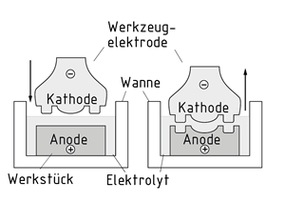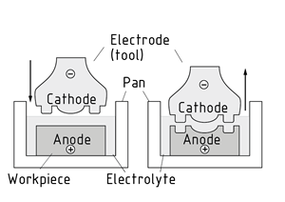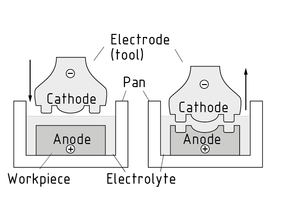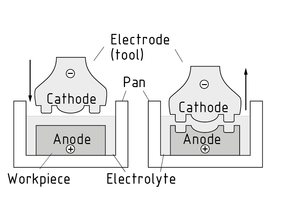
Wählen Sie eine
oder mehrere Sprachen aus
0,1,0
- Deutsch
- Englisch
- Chinesisch
- Spanisch
Elysieren

Elysieren ist ein elektrochemisches Abtragungsverfahren unter Einsatz der Elektrolyse. Dabei gehen unter dem Einfluss von Gleichspannung Metallatome der Anode (das abgesenkte Werkstück) in der wässrigen Lösung von Salz oder Säuren als Elektrolyten in Lösung. Sowohl das elektrische Feld wie die Elektrolytströmung tragen zu einem komplexen Abtrag bei.Dem Werkstück steht die Elektrode (Kathode) gegenüber, die das Negativ der gewünschten Form darstellt. Durch den Spalt zwischen Werkstück und Elektrode fließt der Elektrolyt. Der Gleichstrom bewirkt, dass an der Elektrodenfläche Metallionen des Werkstückes vom elektrischen Feld absorbiert, umgewandelt und aus dem Elysierspalt gespült werden. Der Elektrolyt kann auf hohe Geschwindigkeit gebracht werden, um hohe Abtragsraten zu erzielen.Das Elysieren ist die Umkehrung der Galvanisierung. Es ermöglicht gleichzeitig ein Polieren der Werkstücke.
Electrolytic machining

Electrolytic Machining is an electrochemical removal process based on electrolysis. When direct voltage is applied, metal atoms of the anode (the lowered workpiece) dissolve as electrolytes in the aqueous solution of salt or acids. The electric field and electrolyte flow are part of a complex removal process.
An electrode (cathode) represents the negative of the desired shape. The electrolyte flows through the gap between the workpiece and the electrode. The Direct current causes metal ions in the workpiece that are close to the surface of the electrode to be absorbed by the electric field, converted and flushed out of the gap. The electrolyte can be brought to high speeds to achieve high removal rates.
Electrolytic machining is often characterized as reverse electroplating. It also polishes the workpiece at the same time.
电解加工

电解加工是一种根据电解原理的电化学移除工艺。当施加直流电压时,阳极 (电势低的工件) 的金属原子溶解在盐或酸的水溶液中,形成电解质。电场和电解质流动也是复杂移除工艺的一部分。
而电极(阴极)是表示所需造型的负值。电解质流经工件和电极之间的间隙。直流导致工件中靠近所述电极表面的金属离子被电场吸收,发生转化并冲出间隙。电解质可通过高速流动以实现高移除率。
电解加工的特点类似于反向电镀。同时还能抛光工件。
电解加工造型
近义词
电化学加工
Maquinado electrolítico

El maquinado electrolítico es un proceso de remoción electroquímica basado en la electrólisis. Cuando se aplica un voltaje directo, los átomos de metal del ánodo (la pieza de trabajo bajada) se disuelven como electrolitos en la solución acuosa de sal o ácidos. El campo eléctrico y el flujo de electrolitos son parte de un proceso de remoción complejo.
Un electrodo (cátodo) representa el negativo de la forma deseada. El electrolito fluye a través del espaciamiento entre la pieza de trabajo y el electrodo. La corriente directa hace que los iones del metal de la pieza de trabajo que están cerca de la superficie del electrodo sean absorbidos por el campo eléctrico, convertidos y extraidos del espaciamiento. El electrolito puede acelerarse a alta velocidad para lograr tasas de remoción altas.
El maquinado electrolítico es a menudo caracterizado como eletrochapado inverso. También pule la pieza de trabajo al mismo tiempo.
Formado por maquinado electrolítico
